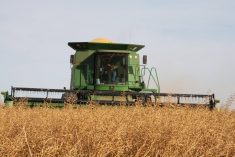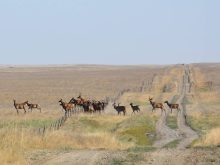Dion Manastyrski left his small family farm as a teenager, and 30 years later his heart remains deeply planted in the memories of his youth.
Indeed, it was appreciation and longing for his rural roots that motivated the photographer to make eight road trips throughout the Prairies from 2003-10 to document what’s physically left on the land from an era that is now gone.
“I wanted to capture the history of the last 100 years of the rural Prairies, starting with the settlers coming in, what their lives were like, the hardships, the good stories, a whole mixture through their voices and photos of things that remains from the past,” he said.
Read Also

Crop quality looks good this year across Prairies
Crop quality looks real good this year, with the exception of durum.
“I wanted to photograph as many old buildings as I could to make a tribute to the settlers and to the homesteaders and to the many decades that followed.”
The resulting book, Prairie Sunset: A Story of Change, is a testament and eulogy to generations past who lived during a time when tiny homes with big families dotted the landscape like a patchwork quilt.
The book’s cover features a photograph of an old wooden house, long abandoned with a golden sun near the horizon.
Manastyrski said he chose the book’s title and the cover image because the Prairies are famous for their sunsets.
“In a way this is meant to capture the era of the family farm, but somebody pointed this out that it evokes the question of what comes next,” he said.
Interspersed among the book’s 240 pages are 100 of Manastyrski’s finely-crafted images, as well as 50 historical black and white photographs and documents he selected from government archives, and a collection of anecdotes of about 70 people he interviewed.
The coffee table sized book is available in many bookstores and direct marketed by Manastyrski.
“In my search for understanding as I roamed the homesteads of a vanishing era, I photographed the abandoned structures, and talked to people of the Prairies,” he wrote.
“Collectively, they have a remarkable story to tell, and I would like to share this with you.”
Many of the people he interviewed were retired and lived on farms or in small town communities. Their stories and insights about the past describe experiences, hardships and rewards.
- “When I was about 10 years old in March 1928, my cousin Rosie, 16 years old, beautiful girl, died of scarlet fever…. When my (two) brothers passed away of scarlet fever, my mother was almost dying, she was so heartbroken…. It’s so different what I see now,” said Phyllis (Nychek) Maksymits from Seech, Man.
- “The biggest mistake they ever made was to make a tractor over 50 horsepower. Before that you could make a living off three quarters of land, have chickens, pigs, grow your own food, raise a family,” said Gerald Nelson of Wadena, Sask.
- “I remember in the 1950s, when one of our neighbours got one of the first televisions in the area. A bunch of other boys and I would go over there almost every weekend to watch hockey and Bonanza,” said Ed Hunt of Rose Valley, Sask.
The experience of talking with many octogenarians and a few centenarians prompted Manastyrski to think about society and his own life today.
“We now have it relatively easy,” he said.
“It’s easy to take things for granted and be complacent… We’ve got to be thankful for the fact that these people put up with many hardships. How can I complain about being cold when I have a nice jacket, a car to ride in, a heated house.”
Manastyrski grew up on a small family farm near Fosston in east-central Saskatchewan on a homestead that was settled by his grandparents.
It shaped his life. It was his world.
“My childhood was surrounded with generous people and a vast amount of open space. Everyone seemed to trust one another, more or less,” he writes.
“As kids, when we were seven years old, we would disappear on our bikes all day. Before leaving, Mom would say, ‘be home for supper.’ ”
It was on some of these adventures that Manastyrski first discovered his fascination with abandoned old houses and the need to explore.
His father died when he was a young boy, and his mother held onto the farm as long as possible.
But like many teenagers, he was in a rush to leave home and somehow felt that the farm would always be there, even though it would soon be sold.
Now living in Victoria, and surrounded by ocean, rock and rainforest, Manastyrski tries to retreat to his beloved Prairies at least once a year. He continues to search for the story of his own past and what his grandparents and other immigrants experienced in their early years of settlement.
He said working on the book project has brought him home to where he emotionally connects with his roots and the lessons he learned as a boy. They continue to carry him forward.
And like the photos in his book, but in a strange twist of fate and irony, his own childhood home now sits empty and abandoned as well.
“Thinking back to the last week I had on the family farm, I can only wish I could have that week back,” he writes.
“I would be careful to spend my time wisely, to visit with family and neighbours, appreciate the open space, look at the sky, breathe the air, and enjoy the old farm as long as I could.”
The novelist Thomas Wolfe coined the popular expression, “you can’t go home again.”
While there are elements of truth in that on some levels, Manastyrski sees hope in challenging it.
“I don’t know how you could grow up on a farm and not remain completely attached to it,” he said.
He prefers another well-used line: “You can take the boy out of the farm, but you can’t take the farm out of the boy.”


















